Ukraine Taking The War to Russia
The tables have turned.
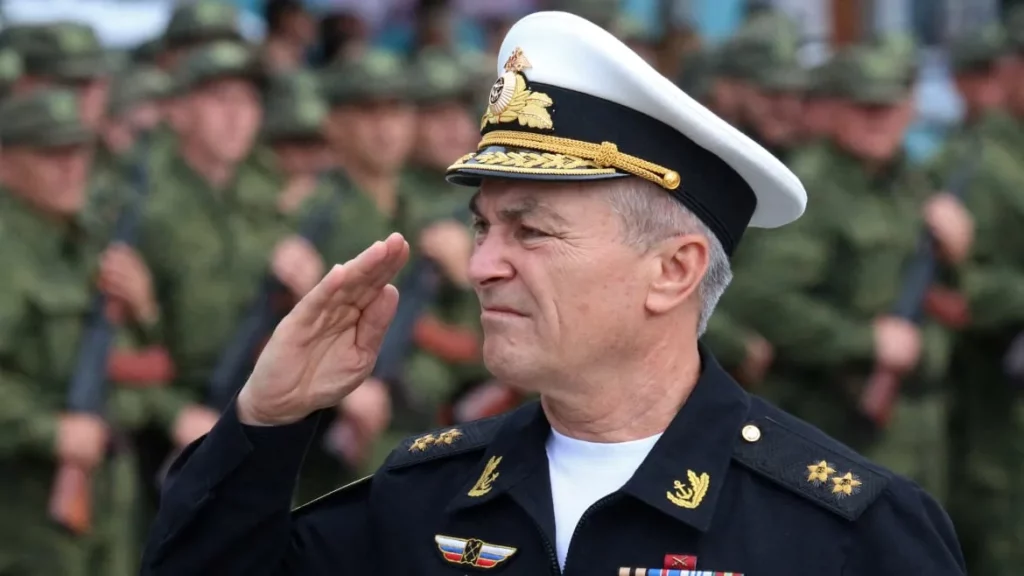
Nico Hines, The Daily Beast (“Russian Naval Commander and 33 Officers Obliterated in Biggest Blow Yet, Says Ukraine“):
In one of the most devastating blows of the war so far, Ukraine says it took out a whole chunk of Russia’s naval leadership in a single missile attack, which killed the commander of the notorious Black Sea Fleet.
Vice Admiral Viktor Sokolov was allegedly killed in Friday’s missile strike on the Black Sea Fleet’s HQ in Crimea, which was illegally occupied by Russia in 2014.
Sokolov, who was drafted in to beef up the faltering navy last year, was attending a meeting of top naval and military figures when the missile crashed into the building in Sevastopol, according to the Special Operations Forces of Ukraine. The Spetsnaz unit claims that 34 officers in total were killed in the explosion.
A huge plume of black smoke was seen billowing from the building last Friday in one of Ukraine’s most stunning missile assaults of the war. The direct hit on the naval command center was a symbolic blow for Russia as the Black Sea Fleet has been a source of national pride since it was established by Catherine the Great in 1783.
President Vladimir Putin fired the commander of the fleet last year after it suffered a series of embarrassing setbacks including the sinking of its lead warship, the Moskva, and an attack on its air base in Crimea that saw eight warplanes destroyed.
Sokolov, who previously held a prestigious role as the head of a military academy, was brought back into active service to reinstate pride in the Black Sea Fleet.
His death—compounded by those of so many of his colleagues—in the heart of the fleet’s operation would represent a severe blow to that pride.
Over the weekend, rumors on social media began to suggest that Sokolov had been caught up in the explosion. The Special Operations Forces posted its confirmation on Telegram on Monday.
“After the attack on the Russian Black Sea Fleet headquarters, 34 officers, including the Commander of the Russian Black Sea Fleet, lost their lives, with an additional 105 occupants sustaining injuries. The headquarters building is beyond repair,” the Telegram statement read.
The special forces unit did not name any of the other victims of the attack by one of the Storm Shadow air-launched missiles donated by Britain and France earlier this year.
Lt. Gen. Kyrylo Budanov, the head of Ukraine’s military intelligence, previously said Col. Gen. Alexander Romanchuk, the commander of Russian forces on the southern front, and Lt. Gen. Oleg Tsekov were seriously wounded in the attack.
Ukraine has been desperate to prove that it can make serious gains in the remainder of the fighting season before winter sets in and, in particular, Kyiv wants to show the skeptical West that it is capable of retaking Crimea.
Benedict Smith, The Telegraph (“Ukrainian drone strike plunges Russian villages into darkness“):
Several villages in Russia’s Kursk region were left without power this morning after a Ukrainian drone reportedly struck an electricity substation.
Kursk governor Roman Starovoit said: “A Ukrainian drone dropped an explosive device on an electricity substation in the village of Snagost in Korenevsky District. Seven settlements were left without power.
“None of the residents were injured. Emergency crews will start restoring power as soon as the situation allows.”
The region, which borders Ukraine, has been a frequent target for drone attacks allegedly coordinated by its eastern neighbour.
Ukraine’s energy minister warned last week that Russia had resumed a campaign against its power stations, which left millions without electricity and water last year.
The Economist (unsigned) (“War has arrived in Crimea“):
Two ukrainian missiles smashed into the headquarters of Russia’s Black Sea fleet before noon on September 22nd. This time, there could be no cover-up. After a Ukrainian attack on a nearby command post two days earlier, censors had scrubbed most social-media posts written by locals. But the daytime strike in central Sevastopol, timed to coincide with a meeting of senior generals, was impossible to hush up. Local chatrooms buzzed with gossip. “Day 576 of a three-day war to take Kyiv,” read one. “What about our red lines? Time to wipe these bloody Ukries from the face of the earth,” another. Amid Ukrainian claims that they had killed the commander of the fleet and another 33 officers, Russian authorities even started turning on early-warning air-raid sirens—something they had previously tried to avoid.
One and a half years in, Vladimir Putin’s war has come to Crimea in earnest. Since the beginning of summer, Ukraine has massively stepped up strikes on the peninsula annexed by the Kremlin in a largely bloodless coup in 2014. Using a mix of new home-made drones and foreign-supplied cruise missiles, it has hit military bases, air bases, and command-and-control centres.
On September 13th a strike on the Sevmorzavod dry dock in Sevastopol took out an amphibious landing ship and one of just six kilo-class submarines capable of launching cruise missiles near the Ukrainian shore. A day later drones and Ukrainian cruise missiles destroyed a cutting-edge s-400 air-defence system that had an export price tag of over $1bn. On September 23rd, a day after the strike on the headquarters, another salvo of cruise missiles hit a pier in Sevastopol. Slowly, and methodically, Ukraine is chipping away at Russia’s Crimean firepower.
Ukrainian military sources say the operations are not necessarily ends in themselves. They should rather be seen as auxiliaries to two more important efforts. The first is Ukraine’s ongoing land counter-offensive, focused on the Zaporizhia region to the north-east of Crimea. Any Ukrainian success in degrading air power, railways and logistics, they say, undermines the Russian troops there who are directly supplied from the peninsula.
The second focus is a naval contest in the Black Sea. Here, Ukraine is trying to deny Russia a monopoly of the sea and to regain control of vital shipping routes. It is destroying Russian warships wherever it can, and pushing the rest out to a distance that makes striking ports, cities and a new sea corridor as difficult as possible. The process began in April 2022 with the sinking of Russia’s flagship Moskva, hit with a home-produced Neptune cruise missile that the navy wasn’t sure even worked. Since then Ukraine has sunk or damaged at least 19 Russian ships.
Ukraine’s economy rests on the success of a new sea corridor in and out of Odessa, announced in August in the wake of Russia’s refusal to extend a grain deal. The safety of the route, which hugs the shoreline inside Ukrainian territorial waters, depends on two things: a bet that Russia will not target civilian ships sailing under neutral flags; and a viable threat of retaliation should that not prove enough.
The latter is already real. At the start of the war Russian warships were positioned menacingly close to Odessa. Today, they rarely enter the north-western Black Sea—a remarkable achievement for a Ukrainian navy without a single operational warship. “The Ukrainians have adapted to become a mosquito fleet [using naval drones, missiles and artillery],” says John Foreman, a former British defence attaché in Moscow and Kyiv. “It’s a classic sea-denial strategy that others used against the [British] Royal Navy in the past.”
Ukraine’s war aim has always been maximalist: not simply pushing Russian troops to the pre-2022 invasion status quo but retaking Crimea. I’m still not sure that’s possible without substantially more Western participation but they’re certainly making it very costly for Russia to hold the territory.
NATO countries, and the United States in particular, have very slowly ratcheted up the deadliness and range of weapons they are willing to supply Ukraine. They’ve just taken possession of US M-1 Abrams tanks and President Biden has promised ATACMS missiles, which have a range upwards of 200 miles. While maddeningly slow from the Ukrainian perspective, it makes sense given Western fears of escalation. It’s not clear what Putin’s “red line” is and at what point he’ll go into desperation mode.

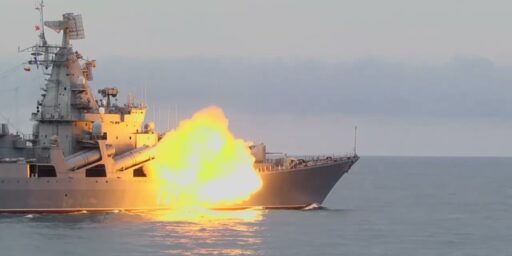
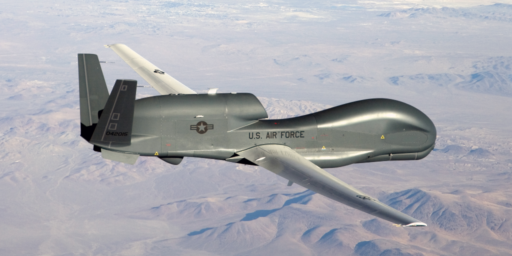
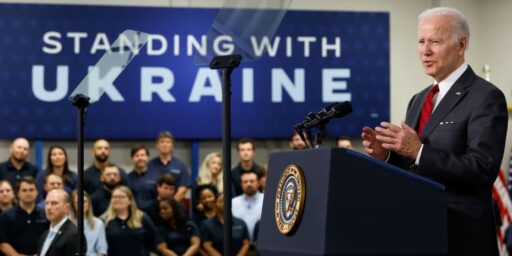
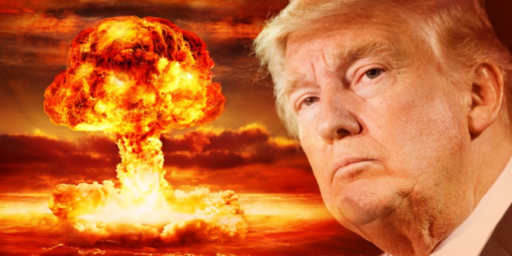
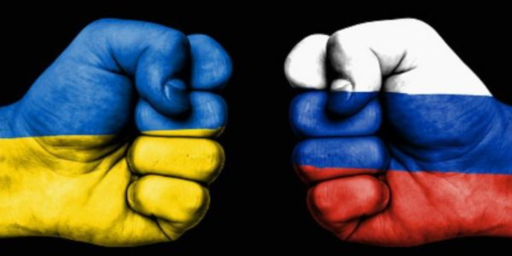
If Ukraine can move on to disrupt Rostov-on-Don, they can put the entire Russian control of the Caucus in question. Armenia and Azerbaijan are already fighting and Russia’s control of Chechnya is a highest bidder matter so civil war there is a possible if the cash and weapons falter.
You have to give the Ukrainians credit. They’ve been very effective in a logistics and leadership interdiction war even in the face of being outnumbered in the face-to-face fighting. Of course, it helps that the Russian forces proved to me no where near what the career American bureaucrats touted in their “expert” opinion for decades.
The “fog of war” and all that still applies. I don’t know enough about Ukraine intel to weigh their statements, but Russian silence speaks for itself.
@JKB: I just finished reading Arkady Babchenko’s “One Soldier’s War”. It is an unforgiving look at the Russian military and how they treat and use their soldiers. It’s a wonder they can fight at all.
Highly recommend Snyder’s Bloodlands or any other good book that covers Eastern Europe from 1930-1955 or so. It documents the extensive killings of Ukrainians by Russians. The deportations and the kidnapping of thousands of children. The current Russian military behaves much like Russians of the past. Makes it very clear why Ukraine is so willing to fight.
Steve
It does feel like there is starting to be a turning point for the better in Ukraine’s offensive. Early days though. But because of that, we should be on guard for the Republican Moscow/pro-facist/religious fanatic contingent to be stepping up efforts to defund Ukraine.
Obviously, I don’t know how serious the Ukrainians are, but Crimea simply has to be their target.
Contrary to the Donbass, Crimea can realistically be isolated. Moreover, it’s a piece of territory where the Russians could never “temporarily” withdraw from. That makes it the perfect place to make the Russian army fight at a potentially severe disadvantage.
Finally, the Russians won’t commit the necessary forces to make this work if Ukraine credibly demonstrates to not be interested in retaking it.
ETA: It is fairly obvious that the Ukrainians have been working hard in recent weeks and months (by chipping away at air defense, naval, and surveillance facilities) to change Crimea from a place that allows one the dominate the Black Sea to a an increasingly isolated strategic liability.
@steve: I read Bloodlands a couple years ago, good book. I feel like I should read it again but at this time I am not yet ready to immerse myself in that horror again.
There’s a supposed report out from Ukraine claiming that Russian military officers who hadn’t received their salaries in some time ended up passing on security info to Ukrainian resistance groups (and got paid for it).
If this is true and not something put out for psychological warfare points Russia is even more vulnerable militarily.
@Grumpy realist:
It could also be something the Ukrainians put out to put that idea in disgruntled officers’ heads.
The walls are closing in. This is the beginning of the end.
Okay, if I did not know better I would swear that the mainstream stories as recently as less than two weeks back talking about Ukraines’ lack of success in their counteroffensive were a deliberate feint, a distraction to keep folks from having a clearer understanding of what had to be an extremely well coordinated and timed effort to decapitate the leadership of Russia’s Navy forces.
It is not just sheer luck and happenstance that the Ukrainians did not end up wasting a precious middle attacking the Naval HQ at the precise time they did.
It makes you go hmmmm, maybe someone from the opposing side really was feeding them extremely valuable Intel and it is both valuable propaganda and true to put it into Putins’ head that his senior leadership is leaking ridiculously valuable information to Ukrainian intelligence.
One last thought, I feel that even if Trump is reelected and wants to “end” the war by handing over Ukraine to Putin, that he is no longer in a position to pull that off. If you take the U.S. out of the picture you still have Europe, the U K., and folks like Turkey who have no longer made it easy to say here Putin, enjoy Ukraine and declare an end to the conflict.
Seriously, I would tell Trump good luck with that.
Like I continually say, treat single-side reporting in this war skeptically. There is already some evidence coming out that Sokolov is not dead and there’s no reliable information yet about who may or may not have been killed in the Fleet HQ strike.
And yes, the Russians will not directly comment for the same reasons that Ukraine doesn’t directly comment when it gets struck – no one wants to give the enemy easy information on the effectiveness of their strikes or intelligence. The fact that they don’t come out and deny Ukrainian claims is normal and should not be interpreted as proof the claims are true.
Anyway, just from an operational perspective, deep strike capabilities, as was demonstrated in this attack are important. The US war-fighting doctrine heavily relies on these capabilities, specifically to avoid the kind of attritional fight that characterizes this war. Hence why the US emphasizes air supremacy to enable deep-battle strikes against a variety of targets.
Unfortunately, that deep-battle capability isn’t just about weapon systems; the US refined our TTPs and doctrine over many decades and you need robust supporting capabilities to be effective.
But the precision long-range strike capability is still useful to Ukraine without the synergies and experience the US has. However, getting on my soapbox again, there is the problem of numbers and sustainment. These are very expensive systems, we don’t have large numbers stockpiled, and production is geared to peacetime replacement requirements, although that is starting to change.
We are likely to see a similar pattern with the introduction of HIMARS last year – some dramatic early successes until the Russians learn and until the missiles we have available in stockpiles are used up. You don’t hear much about HIMARS these days because of these two factors.
@Andy: Arent the Russians going through matériels at the same rate? They no longer deploy many of their intelligent missiles, they don’t deploy their fighter jets, etc. if the Ukrainians can use what they have to push the Russians back and then they run out, it’s not like the Russians will have many long range weapons left to respond.
@Andy:
The Russians can move targets out of HIMARS range. They can’t move Crimea out of range of various cruise missiles and the soon-to-arrive ATACMS. Crimea is their Norfolk/Newport News – naval bases and tourist beaches. If things start blowing up on the regular in Crimea, Russian tourists and civilians will start streaming home. It’s going to be tough for Putin to explain how everything is going great when Boris and Natasha have to cancel their vacation plans.
Panic the civilians, let them evacuate, then destroy the already-damaged Kerch bridge. If Ukraine can destroy the bridge and cut land routes into Crimea, or at least bring them under artillery fire, the peninsula and whatever is left of the Black Sea fleet, is in trouble. The Black Sea won’t be a Russian lake, it’ll be a Turkish lake. The most likely outcome IMO is a cut-off, besieged Crimea, with Ukrainians systematically wiping out the Black Sea fleet and any army units left in place. We may have a frozen conflict by rainy season, but it may be frozen with Crimea untenable. Then what does Putin do?
@MarkedMan:
Yes, and they’ve also experienced shortages, particularly of longer-range missiles. But they produce these domestically, and overall they’ve been moving to war-production in anticipation of a long war. So far, the sanctions don’t seem to have had much effect on Russian war material production.
In addition, they’ve been bringing in additional production from Iran and North Korea for key capabilities, like drones.
In short, they have an advantage compared to Ukraine, which is almost entirely dependent on the West, which has been slow to ramp up production capabilities and is naturally reluctant to empty stockpiles. Russia already had higher production of several types of munitions – especially artillery – because it’s long been an artillery-focused army while the West relies more on airpower for fires.
@Michael Reynolds:
Ukraine is reportedly getting the older block 1 variant of ATACMS, which can’t range most of Crimea. And then, you need to consider launch locations. A lot of maps you see online assume range from the current front line, but that’s not accurate for reasons that should be obvious. Ukraine must keep such valuable systems out of the range of Russian eyes and weapons so the firing locations would be far behind the front lines, meaning less Crimea coverage. And, typically, maximum “on paper” ranges are not realistic operational ranges for reliably using the weapons.
And, again, from media reports and leaks, the US reportedly only has about 1,500 ATACMS of all variants in inventory—the older versions number just a couple of hundred. Several allies have ATACMS as well, assuming they are willing to pull from their limited stockpiles, Ukraine could get a few more.
The 2023 defense bill authorized purchasing another ~1,700 missiles, but it’s unclear how long it will take to produce them as that is a multi-year contract.
Again, issues of production and sustainment are critical as this is very likely to be a long war.
So, do not expect ATACMS to be decisive, especially since the stockpile of these weapons is small.
I would just try to warn everyone again about the dangers of fetishizing specific weapon systems. Wars on this scale are societal-level conflicts that are not won and lost because of the introduction of some kind of wunderwaffen.
@Andy:
Some Russian mil-bloggers have lately been puzzling over the targeting of cheap-ass D-20 towed artillery pieces with quarter million dollar HIMARs rockets. HIMARs is in their news, anyway.
This may be good news for Ukraine.
But it’s probably not a critical strike.
Perhaps more important has been the UAF taking out the main S-400 system in Crimea, a Kilo sub and a Ropucha landing ship, and rendering two of the main dry docks in Sevastopol unusable for some time.
In addition, it appears Russian patrol ships are having to cover the Novorossiysk to Bosporus shipping route, after Ukraine has damaged at least one oil tanker on that run; and Ukraine is targeting those patrols.
This seems to be reducing Russian ability to interfere with the Ukrainian route to the Bosporus; at least two grain ships have made the run, it seems, keeping within NATO waters for almost the full distance.
The loss of the (second) S-400 has made Crimea generally much more vulnerable; as it seems to be the main radar and control units, not the launchers, that were destroyed. Which perhaps what enabled the missile strike on Naval HQ.
Perhaps more importantly, Ukrainian continues to grind forward in several key places that could enable it to place GLMRS launchers in range of key road and rail routes in the south, while keeping both them, and their defenses, out of range of Russian guns.
Combine that with multiple options for renewed attacks on the Kerch Bridge, and the Russian southern salient begins to look a bit sickly.
Especially as, if this is the Ukrainian concept, there seems no reason why it cannot continue into late autumn and on into winter.
(Southern Ukraine is a drier in late autumn and spring, and also less cold in winter, than up around Kyiv and the northern Donbas)
@Andy:
Kherson to Sevastopol is 147 miles as the missile flies, according to the Google machine. It’s 152 miles from Robotyne to the Kerch bridge. Yes, the Ukrainians can’t just fire from the nearest straight line location – I’m sure the Russians have at least a few SAMs left – but I’ll bet a dollar it plays out as I suggested: more loud explosions in Crimea, Russian civilians flee, Ukraine destroys the Kerch bridge, brings all rail and road links to Crimea under fire, Sevastopol is ever more vulnerable, rainy season slows things way down and we have a (temporarily) frozen conflict. Come spring the Ukrainians have all the toys, the Black Sea fleet has abandoned Sevastopol and Putin is borrowing poorly-maintained rounds from the Norks.
@OzarkHillbilly: I highly recommend Zinky Boys which is a look at the soviet invasion of Afghanistan